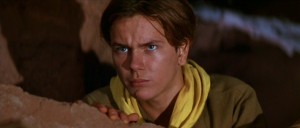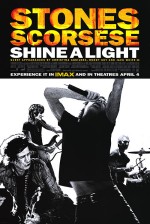[This post is a part of the Indiana Jones Blog-a-Thon, hosted by Ali Arikan's Cerebral Mastication.]
One aspect of the Indiana Jones series that has always intrigued me is the way that the filmmakers link the episodes together without utilizing the cause and effect of conventional plotting. When making three (or four) films about the same character, the filmmakers could presumably connect the events of the films together directly, such that an audience will be compelled to return to the series to find out What Happens". Significantly, the Indiana Jones series doesn't do this.
Rather, Spielberg presents each film with a self-contained plot that has little effect on subsequent episodes. There is almost no explicit acknowledgment that the events of the previous films have occurred, save for the occasional wry joke. Despite this absence of a typical through-line for the series, three elements link the films together: 1) their protagonist; 2) their pulp adventure tone; and 3) their use of a supernatural artifact as a MacGuffin. This discrete, episodic style, inspired by the serialized adventure shorts of the 1930s, is a hallmark of the films and a key component of their appeal. It's a style rarely mimicked by other adventure film franchises, although a certain British secret agent originated and still follows it. I can see what's appealing about this sort of structure to the filmmakers as well. Each film sets up and then quickly resolves a conflict about an artifact, freeing Indy—and the filmmakers—to move on to the next chase.
That said, Spielberg does provide us with an unbroken plot arc that ties together the films of the series. However, it is a plot arc that runs not through the film's more tangible elements, but through the inner world of its protagonist. For example, the quest for the Sankara Stones in Temple of Doom has no connection to the quest for the Ark of the Covenant in Raiders. Yet what happens to Indy in Temple does has an effect on the events in Raiders, in the sense that the moral changes wrought by the events in Temple affect his actions in the later films. I think that this isn't immediately apparent to some viewers. The series has suffered some criticism for "resetting" Indy's stance at the beginning of each film, in the sense that he is always somewhat skeptical and world-weary when we meet him. Despite this, I think it's arguable that, for example, the Indy of Raiders is a different man than the Indy of Temple, and this almost certainly affects Raiders' story (albeit in hindsight).
If we rearrange the events of the three extant films into chronological order, plucking out the prelude in Last Crusade and placing it first, then a plot of "character events" emerges, one that spans the series and operates on a higher level than the plot of "substantive events" within each episode. Let's take a quick glance at some events in each episode with an eye toward those with broader moral significance for Indy's character.
The Last Crusade Prelude (1912)
Indy attempts to steal the Cross of Coronado from a group of mercenary relic hunters, professing that he is motivated by academic idealism ("This should be in a museum!").
Significant Moral Lessons: Even individuals motivated by idealism can suffer defeat if they are inexperienced, and particularly if less scrupulous rivals have the backing of corrupt authority figures.
The Temple of Doom (1935)
During the film's opening scenes, Indy attempts to trade the remains of Nurhaci to the gangster Lao Che in exchange for a large diamond. This represents a reversal of Indy's previously professed academic idealism, in that he is gives up an item of cultural value (the ashes) in exchange for an item of monetary value (the diamond). Also note that Indy threatens Willie Scott (an innocent), first to fend off a threat of violence from Lao's son, and then in an attempt to obtain the antidote to a recently ingested poison. This is a fairly callous act that seems out of character with the Indy we were introduced to in Raiders.
After fleeing China, Indy agrees to help an Indian village recover its lingam, stolen by Thuggee cultists that have infiltrated the court of the local maharaja. The village's children have also been kidnapped by the cultists. A clue indicates that the village lingam may be one of the legendary Sankara Stones. Here Indy seems to be motivated by a mixture of compassion for the village and lust for "fortune and glory".
After infiltrating the maharaja's palace, Indy witnesses the Thuggee committing gruesome human sacrifices in a secret temple. He also discovers that the Thuggee have three of the Sankara Stones, including the village lingam. Indy steals the Stones, but is distracted by his discovery that the village children have been enslaved to work the cult's mines. Shortly thereafter, Indy is captured and drugged so that Mola Ram can control his will. He is liberated from this state by Short Round, and eventually Indy rescues the village children and returns the lingam to the village. In doing so, he curses Mola Ram, casting the other two Stones into a river. Happily, returning the village's stone restores its prosperity.
Significant Moral Lessons: Pursuing artifacts as a means to "fortunate and glory" risks a disregard for human suffering. Obsession with fortune and glory is a hallmark of individuals who engage in brutality and depravity, and indulging in such obsessions risks identification with such individuals.
Raiders of the Lost Ark (1936)
Faced with evidence that the Third Reich is close to uncovering the Ark of the Covenant, Indy agrees to help the United States government find and secure the Ark before the Nazis do so. Although he has an assurance that his university museum will eventually receive the Ark for its collection, Indy is also thrilled at the prospect of hunting for such a prize.
Following a long struggle and chase for possession of the Ark, the Nazis and Indy's archrival René Belloq arrive at an island with both the Ark and Marion Ravenwood—Indy's friend and lover—in their captivity. Indy threatens to destroy the Ark of the Covenant with a rocket if the Nazis do not release Marion. However, Belloq intuits that Indy is bluffing: he is unwilling to destroy such an important artifact. Indy is quickly captured, and it is the power of the Ark itself that eventually destroys the Nazis.
Significant Moral Lessons: Excessive attachment to the cultural worth of artifacts can inhibit one's judgment and preclude the resolve necessary to ensure the safety of loved ones.
The Last Crusade (1938)
Indy agrees to search for the Holy Grail for private collector Walter Donovan, but only after it is revealed that Indy's father has vanished while searching for the Grail himself. Indy initially conceals his father's Grail Diary from his contact, Elsa Schneider, out of wariness for her motives. Eventually, Elsa—secretly a Nazi—tricks Indy into her confidence. During a chase through the canals of Venice, Indy threatens Grail guardian Kazim with death to obtain knowledge of his father's whereabouts. However, when Kazim refuses to relent and risks both their deaths, Indy backs down.
Indy eventually finds his way to the temple where the Holy Grail is kept. Although he recovers the Grail, Elsa's greed triggers a divine earthquake that claims her life. Similarly, Indy foolishly risks his own death while trying to save the Holy Grail. However, his father persuades him that a mere object, no matter how valuable, is not worth his life.
Significant Moral Lessons: Excessive attachment to the cultural worth (or supernatural power) of artifacts can provoke irrational risks to one's own life.
Despite allegations of the series's episodic "resetting," I think it's apparent that a clear moral plot emerges when the series is approached as a larger work. Indy's struggle against the hobgoblin of "treasure hunter's fever"—an exhilarating lust for and strong attachment to cultural artifacts—is probably the series' most prevailing moral conflict. Although Indy learns to suppress his personal ambitions and to prioritize humanitarianism (Temple), the safety of loved ones (Raiders) and his own life (Crusade) over such treasures, the thrill of artifact discovery and recovery is still seductive to him.
I think this is one reason why criticisms of a neo-colonialist current in the series, while legitimate, don't trouble me to the point of distraction. The cartoonish villainy of the Nazis and cultists serves to draw attention to the true core moral conflict of the series: Indy's battle with his looting and pillaging impulses. The super-plot is not about Stones or Arks or Grails, but about how Indy tries to arrive at a "moral archeology" by negotiating (but never vanquishing) the distractions of avarice, fame, obsession, elitism, and ego.













